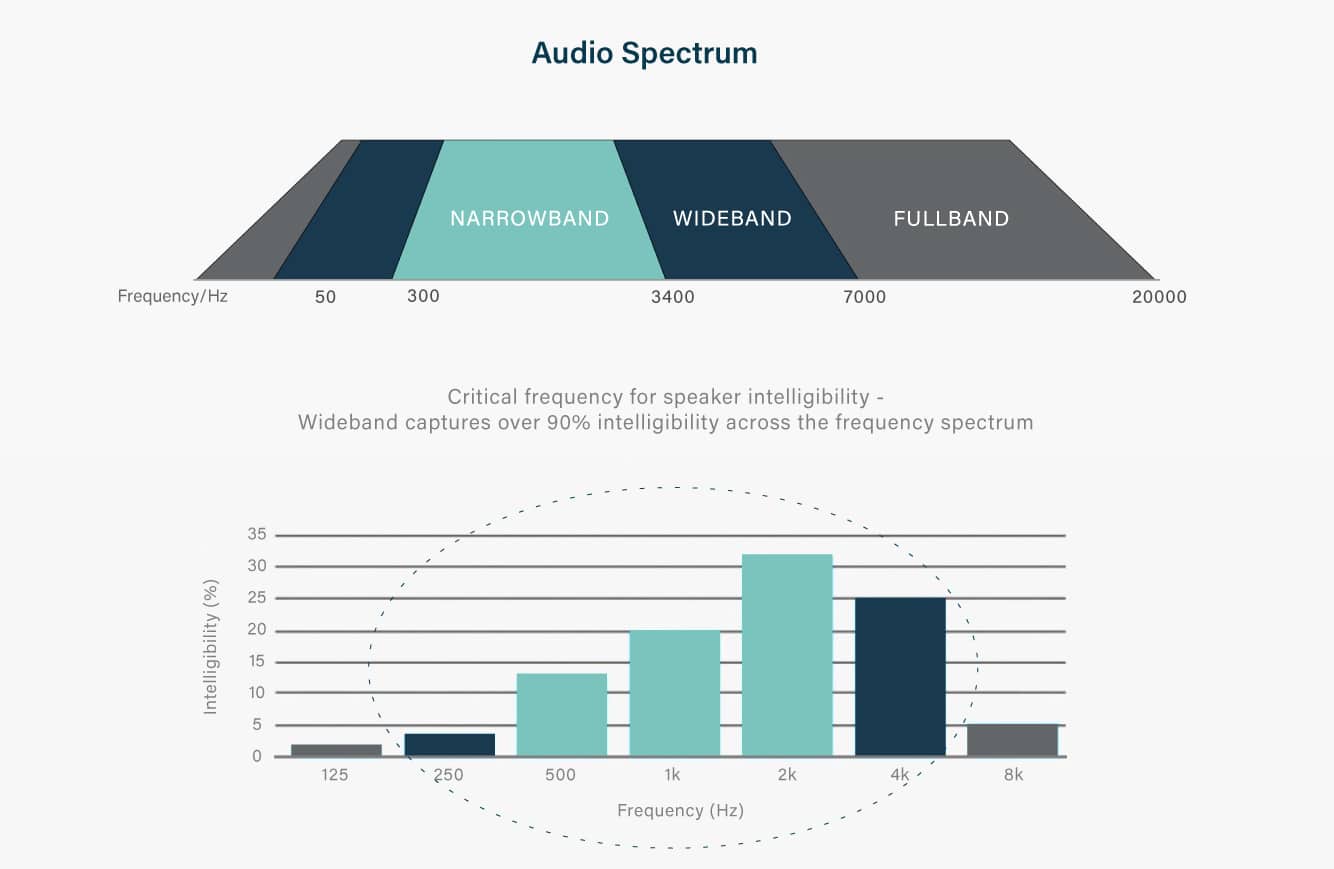Why It Matters: Wideband Audio in IP Endpoints
All Algo devices support wideband audio (G.722 voice codec) for improved sound quality and speech intelligibility to enhance VoIP communication for voice paging, emergency notification, and audible alerting.

Wideband Audio
The human ear can detect sound between a frequency range of 20 Hz to 20,000 Hz. Being able to differentiate the rates in frequency is how we are able to perceive communication as it gives us more audio to react to – from a low bass tone at around 100 Hz to a high pitch tone at around 8,000 Hz. Our ability to effectively understand and recognize patterns in speech is the foundation of communication. Being able to interpret sounds as meaningful words that formulate messages comes down to two things – is it loud enough and is it intelligible.
Sound volume can easily be managed on most speakers so as to reach a decibel that is loud enough to be easily and safely heard. With Algo IP speakers, adjusting the volume can be done right from the web interface and they have 10 levels to suit any environmental needs. If automatic volume control is preferred, Algo speakers are capable of ambient noise detection.
Audio intelligibility, however, is influenced by the frequency in which our ears can detect sound waves. The most critical frequency for speech intelligibility is at the 2,000 Hz mark, but many other frequencies play a critical role in speech intelligibility, and it is the range of frequencies that contribute to intelligibility.
As a rough guide:
- Under 250 Hz contributes greatly to bass, but only 2% of speech intelligibility
- Around the 250 frequency contributes to roughly 4% of speech intelligibility
- Around the 500 frequency contributes to roughly 13% of speech intelligibility
- Around the 1,000 frequency contributes to roughly 20% of speech intelligibility
- Around the 2,000 frequency contributes to roughly 33% of speech intelligibility
- Around the 4,000 frequency contributes to roughly 25% of speech intelligibility
- Above the 8,000 frequency contributes to roughly 5% of speech intelligibility

Certain speakers are capable of delivering different frequency ranges. The element of the speaker that determines this capability is the audio codec. The most commonly referenced audio codecs in VoIP communication are G.711, which is commonly known as narrowband, and G.722, known as wideband. The third codec, known as fullband, is available on all Algo IP speakers, however, it is not the main focus for this article as it does not contribute as much to speech intelligibility.

Sound is generally measured in Hertz (Hz) and Decibels (Db):
- Hertz measures the frequency of sound – whether it is low or high pitch
- Decibels measure the intensity of sound – how loud is it
What is Wideband Audio?
Wideband audio, sometimes referred to as HD (high definition) audio, is a frequency range that provides better sound quality in the UC environment for VoIP calling, paging, announcements, notifications, and music. It provides a wider range of frequency compared to narrowband – where on the lower end of the spectrum it offers more bass, down to 50 Hz (narrowband stops at 300 Hz), on the higher end of the spectrum it offers more speech intelligibility, stretching up to 7,000 Hz (narrowband stops at 3,400 Hz). The bandwidth of the frequency makes a significant difference in the listening experience as it helps to distinguish tones and pitches when using headsets and speakers.
On its own, the vocal range of a typical human voice extends between 100 to 17,000 Hz. With traditional telephony offering only narrowband audio, this will only cover a range of 300 to 3,400 Hz. Wideband audio has a broader bandwidth and can achieve a greater range of frequency from 50 to 7,000 Hz. Wideband audio makes it easier to understand speech, especially hard consonant sounds which, in western languages, often require the 4,000 Hz band to decipher between similar sounding consonants – a capability beyond the spectrum of narrowband.
Why It Matters
Audio is the primary method of communication and is received through speech, various tones, alarms, and music. Having clear, concise messaging strongly assists in the absorption of information and allows listeners to respond accordingly.
Wideband audio allows us to distinguish different tones and sounds, but more importantly, it helps us recognize consonants which enables us to determine the difference between similar sounding, or rhyming, words. With wideband audio, a speaker can be more clearly heard over a PA system and their instructions can be better understood and followed. In the case where an alert is played, there is more distinguishability between sounds used, thus different tones can be assigned for different warning types. Read more about different tones and how they carry in the Emergency Alerts section below.
Speech intelligibility: Critical speech
In the event of an emergency, it is important to have cooperation from everyone. However, that cooperation comes with understanding. If a voice over the PA system is instructing everyone to line up in single file, the message is only as good as it is understood. A message needs to be perceived in the correct sense as a matter of safety. Being able to easily process and understand messages in emergency situations can bring a sense of ease to the audience as they are able to understand clearly what is being said, understand what they need to do, and understand that the situation is being controlled. While an accent, the speaker’s distance from a mic, or individual’s voice can contribute to confusion, the audio quality of a device can play a strong role in a person’s misinterpretation and befuddlement.
For clear communication in speech, important frequencies in non-tonal languages require a frequency band of around 2,000 Hz for basic intelligibility – most consonants are found in this frequency band. Vowels are predominantly in the frequency range of 250 Hz to 500 Hz and, as mentioned above, speech intelligibility is delivered in the consonants which require information in the range of 2,000 Hz to 4,000 Hz. For even more depth in speech, wideband audio can deliver an even broader range of frequency up to 8,000 Hz, which makes pitch, timbre, and tone come out crisper and clearer. Pitch allows us to hear intonation in a language, timbre allows us to distinguish vowels and consonants that make up a word, and tone is the quality or emotion of the voice. Above approximately 1,000 Hz, the energy of vowels at a normal vocal intensity diminishes rapidly.
Understanding these frequency ranges allows us to recognize the range in which humans can perceive speech most effectively. Using wideband audio enhances the natural sound of speech. It also minimizes the difficulty of hearing calls in crowded places, which reduces strain and stress while promoting cognitive relaxation.
This provides an optimal solution for environments, such as transportation, where background noise may affect comprehension. When sound is played from the speakers, wideband audio will help the audience distinguish between words that may sound similar but have slight differences in timbre and pitch.
Music Performance
Wideband audio also has a positive effect on music quality. With HD audio, music sounds better due to both the higher and lower frequency ranges. The lower frequencies allow for more richness of bass performance, and the higher frequencies ensure a more harmonic sound and allow us to hear more intonation in the notes and distinguish unique sound qualities.
Emergency Alerts
For effective emergency alerting, different tones can be used in different environments for specific purposes. For example, bass tones can travel further than higher tones. For this reason, many transportation vehicles, such as trains or boats, use a foghorn which carries a deeper tone for it to reach an audience that may be farther away to alert of their approach. A higher frequency tends to be more attention-getting. High warble tones could be used in a classroom or office to alert of a fire or hazard. Our response to high tones is likely biology driven and is similar to our response to the cry of a baby.
Wideband in Algo Devices
As Algo IP devices support wideband audio which covers more bandwidth, they can work with a greater frequency range to produce a higher quality of sound. This means that audio from an Algo device is easier to understand and provides a more pleasant listening experience.
Wideband audio in Algo devices serves to reduce strain on your cognitive conscious so messages, notifications, and alerts can be delivered more reliably for effective communication and action. In speech, wideband audio provides ease of conscience, less cognitive stress, and clarity in message delivery, and in music, it provides richness of bass, clear tones, and a soothing audio experience.
The speakers required in each environment could be different depending on several factors, such as background noise and intended use. Higher tones could be desired where the focus is primarily on delivering paging messages or pre-recorded messages, and lower tones for environments where background music and deeper tones are the preference.
SALES SUPPORT
Do you have a sales inquiry?
Contact support for anything you need.